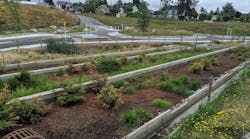Stormwater Best Management Practices: Preparing for the Next Decade
Since November 1990, when EPA promulgated the first phase of the National Pollutant Discharge Elimination System (NPDES) stormwater regulations (Phase I), a large amount of data and experience has been obtained on the impact of runoff and the effectiveness of runoff controls. The Phase I program directly impacted 173 cities, 47 counties, and approximately 40 additional local and state governmental departments (USEPA, 1999[a]). To date, more than 250 Phase I local government permits have been issued (Figure 1). Those permits address the operations of 800-plus governmental units. Figure 1. Required Permits
Number of local government permits required under NPDES Phase I and Phase II stormwater rules.As a result of Phase I and the growing attention to stormwater issues, tens of thousands of postconstruction runoff control best management practices (BMPs) have been installed. In the engineering staffs of many municipalities and state departments of transportation, there has been a noticeable shift from designs that take a relatively narrow “drainage” view to those that provide for runoff control features such as in right-of-way detention, filtering, and biological treatment. In some cases the design shifts have been small: for example, placing an emphasis on the use of grass swales instead of concrete or rock-lined drains. Still, the net impact has been to raise awareness and to train many planners and engineers in some of the principles of improved stormwater management. Many Phase I cities and counties have established stormwater utilities charged with meeting the Phase I permit requirements. In carrying out that charge, those utilities have significantly increased local government awareness and understanding of stormwater issues.EPA understood the limitations of the available information on the impacts and sources of urban nonpoint-source pollution when it designed the Phase I program. While requiring some immediate actions, such as prohibiting nonstormwater discharges into stormwater systems, EPA used Phase I as a mechanism to collect data and increase the state of knowledge about the problems. Specifically, Phase I permittees were required to:identify nonpoint sources,develop meteorological data,estimate volumes and quality of stormwater discharges,prepare lists of receiving water bodies and compile information on the impacts of stormwater runoff on those water bodies,characterize discharge quality and the areas producing that discharge,develop estimates of annual pollutant loads and event mean concentrations,develop management programs that would reduce pollutants in runoff,monitor the implementation of the management program and its impact on water quality.Drainage problem or nonstructural BMP? A shift in thought about drainage and stormwater retention will help meet Phase II objectives.Today’s planners and engineers are benefiting from the data and experience generated by the Phase I program. A number of studies have used the information coming from Phase I, including studies summarized in previous issues of this magazine, to help us better understand the impacts of stormwater runoff and to design structural and nonstructural means of reducing or mitigating those impacts. EPA, under a consent decree, promulgated the NPDES Phase II rule in 1999. Phase II expands federally mandated stormwater controls to about 3,500 local governments. It further expands controls during construction activities to sites equal to or greater than 1 ac. (down from 5 ac. in Phase I). This part of the program is estimated to affect about 110,000 construction sites per year (USEPA, 1999[a]). The final size of the program is likely to be significantly larger than what was federally mandated. The Phase II rule provides designated NPDES state programs with the authority to add communities to the program. Also, in compliance with the Clean Water Act, Phase II provides for citizen petitioning for community designation. In North Carolina, the Division of Water Quality has proposed state rules that would designate 20 counties, which were not federally designated as “urban counties.” The state rules would require these countries to obtain Phase II permits (North Carolina Division of Water Quality, 2001). Additionally, some citizen and environmental groups are preparing to petition for the designation of additional communities along impaired and threatened waterways. Many states, recognizing the need to address their current lists of impaired waters, or 303(d) lists, and to meet antidegradation water-quality goals, will likely adopt a similar broadening of the program. Finally, for more than 18% of the states’ nearly 22,000 impaired waters, urban runoff and other nonagricultural nonpoint-source pollution are listed as the leading sources of impairment (USEPA, 2001). Many of the local governments around those impaired waters will eventually be added to the Phase II program. Although there is a large amount of overlap between runoff-impaired waters and the Phase I and II designated communities, total maximum daily load (TMDL) implementation plans will likely add hundreds of communities to the Phase II program during this decade.The challenge of urban stormwater management is to make the built environment function reasonably similar to the undeveloped watershed.This discussion leads to a logical conclusion that this decade will see an order of magnitude increase in the rate of installation of structural and nonstructural BMPs. The data gathered during the past 10 years should provide us with a strong technical foundation on which to plan, design, construct, and maintain stormwater controls. Before we develop and begin implementing our Phase II program, however, we should carefully examine what our goals might be and consider the secondary impacts that our actions might produce.Phase II Objectives The overall objective of the Phase II stormwater rule is simply to provide a mechanism by which the nation can reach the “fishable and swimmable” goals of the 1972 Clean Water Act. That objective can be restated pragmatically as:1. eliminating listings for the water bodies on each state’s 303(d) list solely or substantially as a result of stormwater runoff, and2. providing a regulatory and technical program that will prevent degradation of water quality from stormwater runoff to a degree that additional water bodies become impaired.Table 1. Worksheet for Assessing Secondary Effects of a BMPBMP Type/Location:Receiving Water:Wet Detention Pond Discharging to Grass Swale at Fire Station #1West Branch, Cub CreekImpactsDirection of ChangeHydrologicalEcologicalHumanCommentsPhysicalTemperatureIncreaseNegativeNegativeMitigated by grass swaleDissolved OxygenDecreaseNegativeNegativeMitigated by grass swaleTurbidityNo Change -> IncreasePositiveNegativeNegativeSediment TransportDecreasePositivePositivePositiveStream EnergyDecreasePositivePositivePositiveOutlets are well designed. Headcutting should not occur.InfiltrationIncreasePositivePositiveStream Base FlowIncreasePositivePositivePositiveW.B. Cub Creek can use added summer base flowhelloChemicalNutrientsDecreasePositivePositiveMoss, “slime” seen as problem. BMP should helpMetals and PesticidesDecreasePositivePositivehelloBiologicalPrimary ProductionDecreasePositivePositiveBacteriaDecreasePositiveCub Creek, but not West Branch, is fecal-coliform impairedMosquitoesNo change Salamander PopulationIncreasePositivePositiveFrog PopulationIncreasePositivePositiveToad/Tree Frog PopulationIncreasePositivePositiveFish PopulationsNo ChangeFish DiversityNo ChangeMacroinvertebrate DiversityDecreaseNegativeImmediate reach only; no impact beyond swaleTerrestrial Species HabitatNo Change?Aquatic Species HabitatDecrease -> Increase??helloBMP EnvironmentPhysicalTemperatureIncreaseNegativeNegativeDissolved OxygenDecreaseNegativeNegativeTurbidityIncreaseNegativeNegativeSediment TransportDecreasePositivePositivePositiveSediment trapping; maintenance requiredStream EnergyDecreasePositivePositivePositiveOutlet design is critical to achieving this benefitInfiltrationIncreasePositivePositivePositiveUnlined pond; soil supports infiltration. Watch for silt plugging helloChemicalNutrientsIncreaseNegativeNegativeMaintenance will help avoid eutrophicationMetals and PesticidesIncreaseNegativeNegativeBioaccumulation is a concernhelloBiologicalPrimary ProductionIncrease?NegativeBacteriaIncrease

